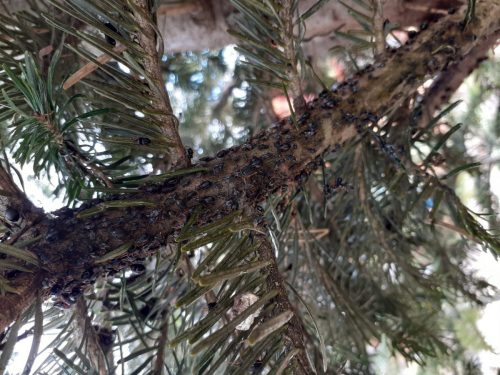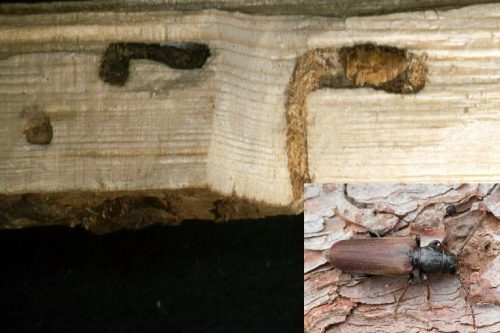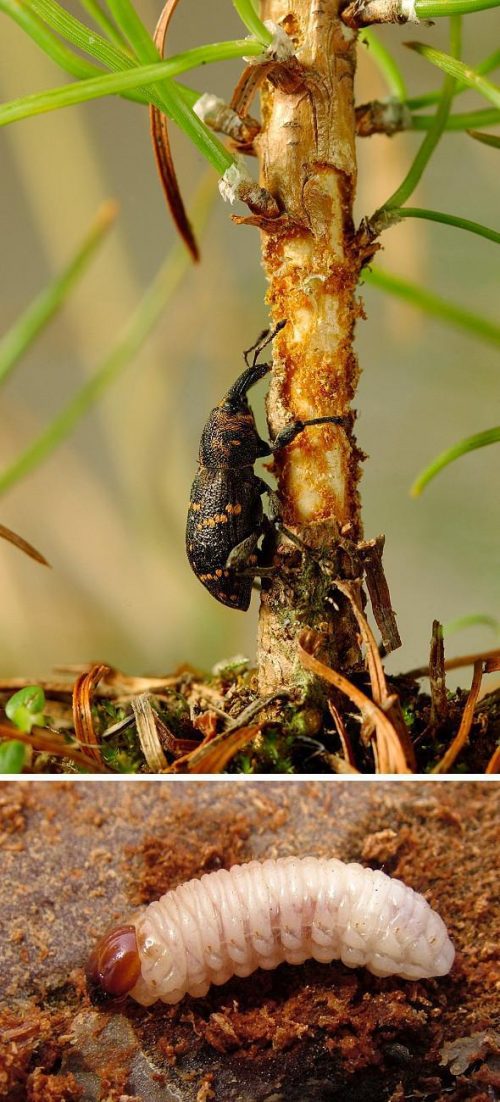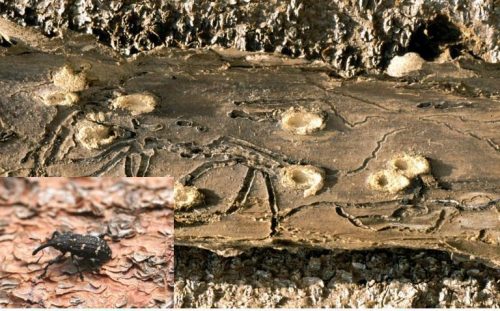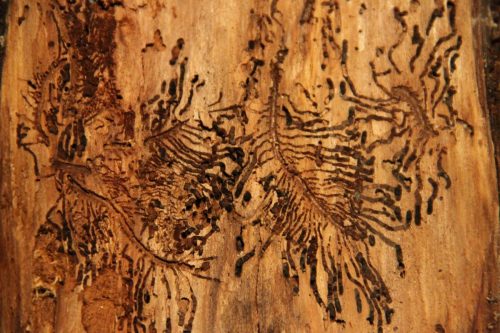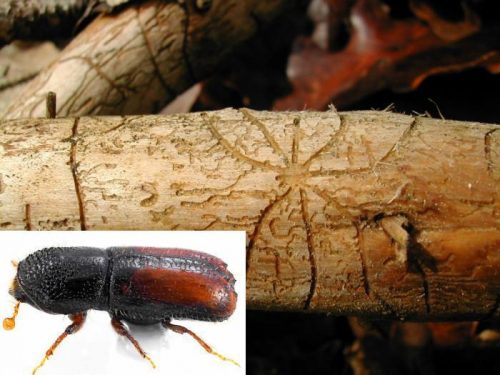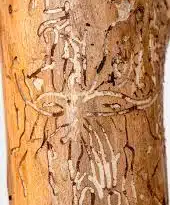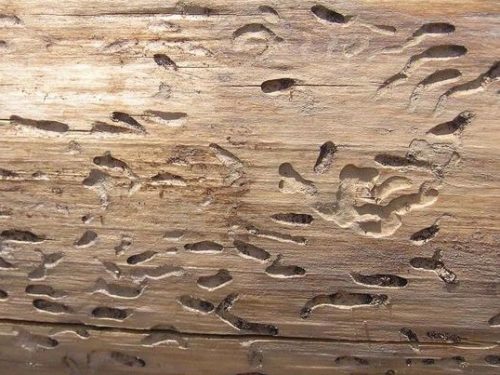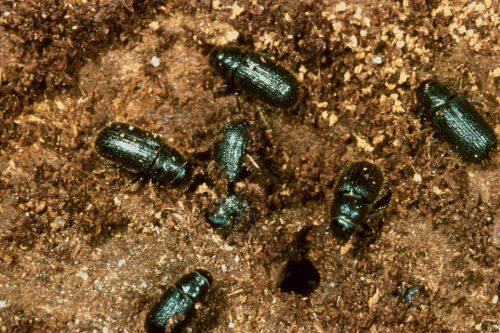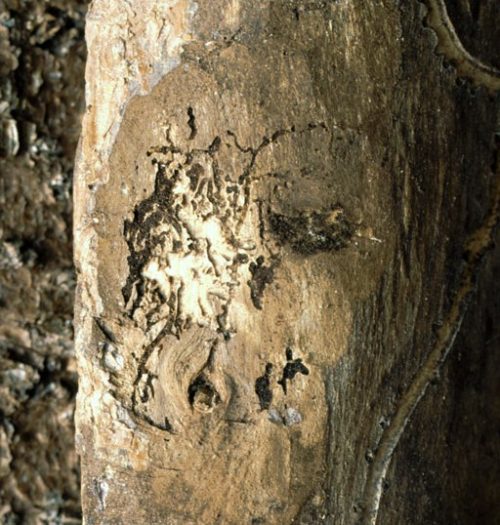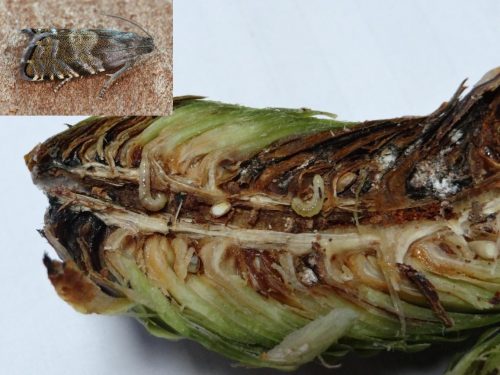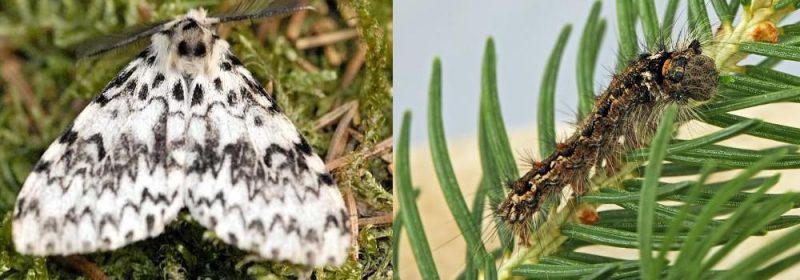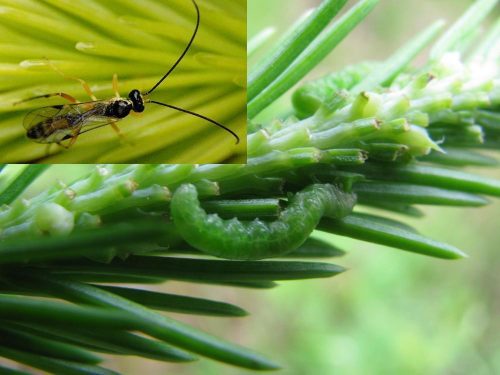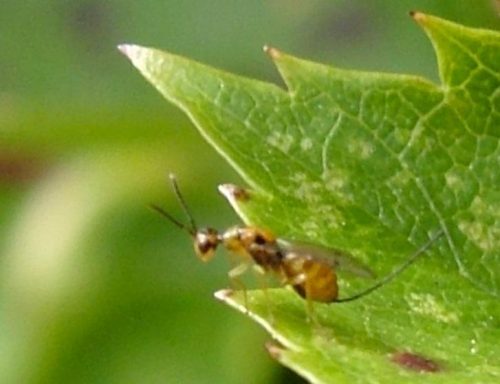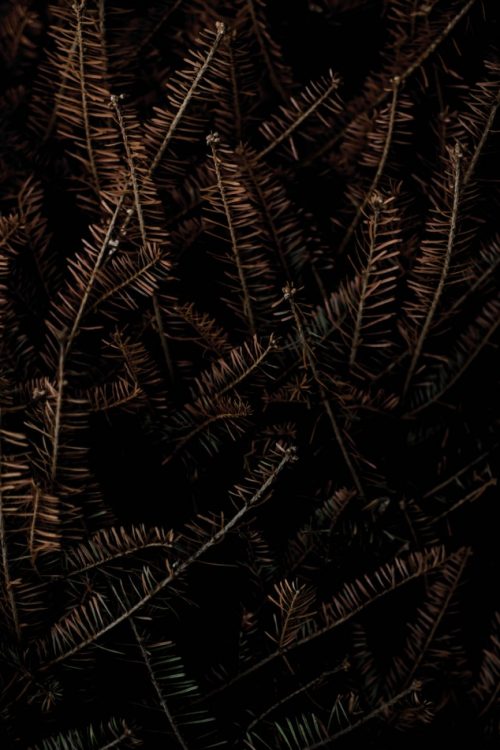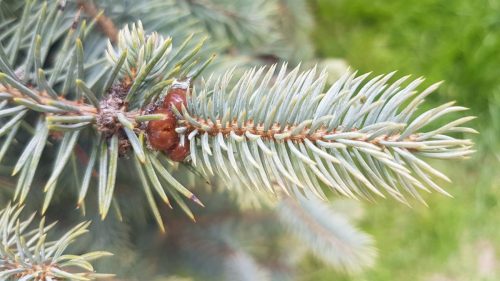Spruce, pest information and treatment
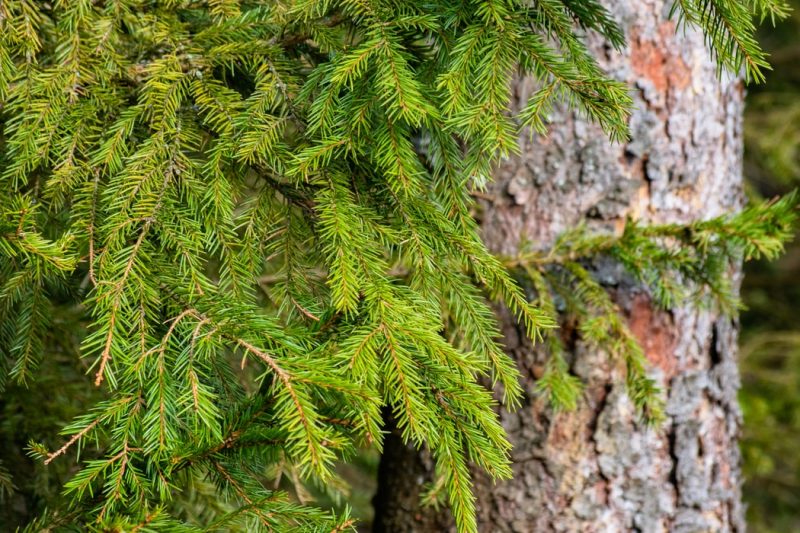
Adelgids
Trees can be affected by the presence of these spruce pests from the Adelgidae family, which produce galls formed by the proliferation of the bark at the base of the needles. There are monoecious species that attack only spruce (eg. Sacchiphantes abietis, Adelges tardus, etc.), and heteroecious species, which form galls on the spruce, after which they change the host (eg. Sacchiphantes viridis – green spruce gall aphid, Pineus cembrae, etc.).
Adelgids are small insects, 2-6 mm in length. Sexual adults are non-winged. They cause injuries by forming galls, by stinging needles and bark, and by sucking sap. Physiological stress is caused to the host, and in case of a severe attack, the resistance of the tree is reduced.
Control methods. The application of chemical treatments with contact or systemic insecticides is recommended. The galls can be mechanically gathered and destroyed.
Recommended products
-
You can find products on a different store
Change Store -
You can find products on a different store
Change Store -
You can find products on a different store
Change Store -
You can find products on a different store
Change Store -
You can find products on a different store
Change Store -
You can find products on a different store
Change Store -
You can find products on a different store
Change Store -
You can find products on a different store
Change Store -
You can find products on a different store
Change Store -
You can find products on a different store
Change Store -
You can find products on a different store
Change Store -
You can find products on a different store
Change Store -
You can find products on a different store
Change Store -
You can find products on a different store
Change Store -
You can find products on a different store
Change Store -
You can find products on a different store
Change Store -
You can find products on a different store
Change Store -
You can find products on a different store
Change Store -
You can find products on a different store
Change Store -
You can find products on a different store
Change Store -
You can find products on a different store
Change Store -
You can find products on a different store
Change Store -
You can find products on a different store
Change Store -
You can find products on a different store
Change Store
Tetropium castaneum – black spruce beetle
This spruce pest attacks both healthy and weakened trees. It prefers spruce, but it has also been observed on pine, fir, and larch. The black spruce beetle has one generation per year, with the flight in July-August, during the day. Eggs are laid under the rhytidome. The insect overwinters in the larval stage, inside the wood. Larvae are the ones that cause damage by chewing galleries in the bark, in the wood, and between them. The attack can be observed by the oval exit holes that adults gnaw into the bark. In case of a severe attack, the detachment and fall of the bark can be noticed. Larvae consuming woodpeckers can be frequently seen on the affected trees.
Control methods. It is recommended to cut and destroy the attacked trees before the flight of the adults. Pheromone-baited and chemically treated trap logs can also be used for monitoring and control. These should be peeled in the summer before the larvae enter the wood. In the egg or larval stage, insect growth regulators can be applied. Contact insecticides are recommended only in case of mass multiplication.
Recommended products
-
You can find products on a different store
Change Store -
You can find products on a different store
Change Store -
You can find products on a different store
Change Store -
You can find products on a different store
Change Store -
You can find products on a different store
Change Store -
You can find products on a different store
Change Store -
You can find products on a different store
Change Store -
You can find products on a different store
Change Store -
You can find products on a different store
Change Store -
You can find products on a different store
Change Store -
You can find products on a different store
Change Store -
You can find products on a different store
Change Store -
You can find products on a different store
Change Store -
You can find products on a different store
Change Store -
You can find products on a different store
Change Store -
You can find products on a different store
Change Store -
You can find products on a different store
Change Store -
You can find products on a different store
Change Store -
You can find products on a different store
Change Store -
You can find products on a different store
Change Store -
You can find products on a different store
Change Store -
You can find products on a different store
Change Store -
You can find products on a different store
Change Store -
You can find products on a different store
Change Store
Hylobius abietis – large brown pine weevil
It is one of the most important pests of conifer plantations. Usually, 2-5 years old conifer seedlings are attacked, especially spruce. It has a generation in 2 years and overwinters one year in the larval stage (in wood) and the next year as a young adult (in the litter, moss, or in cracks of the bark). The adults gnaw the bark of the stem of the seedlings (spot appearance), and through these wounds, resin leak occurs. Sometimes adults can gnaw the bark of thin branches of older trees. The larvae feed on the roots of the stumps, so they do not represent importance for pest control.
Control methods. In the nurseries, spruce bark traps can be placed between the rows of seedlings. Adults will gather under them so that the mechanical control can be performed by gathering the destructing insects. Pheromone-baited and chemically treated trap logs can also be used for monitoring and control. Chemical control of this spruce pest is done with toxic bark traps, treated with contact or ingestion insecticides.
Recommended products
-
You can find products on a different store
Change Store -
You can find products on a different store
Change Store -
You can find products on a different store
Change Store -
You can find products on a different store
Change Store -
You can find products on a different store
Change Store -
You can find products on a different store
Change Store -
You can find products on a different store
Change Store -
You can find products on a different store
Change Store -
You can find products on a different store
Change Store -
You can find products on a different store
Change Store -
You can find products on a different store
Change Store -
You can find products on a different store
Change Store -
You can find products on a different store
Change Store -
You can find products on a different store
Change Store -
You can find products on a different store
Change Store -
You can find products on a different store
Change Store -
You can find products on a different store
Change Store -
You can find products on a different store
Change Store -
You can find products on a different store
Change Store -
You can find products on a different store
Change Store -
You can find products on a different store
Change Store -
You can find products on a different store
Change Store -
You can find products on a different store
Change Store -
You can find products on a different store
Change Store
Pissodes harcyniae – Norway spruce weevil
It is one of the spruce pests, causing damages especially to weakened trees, sometimes to healthy trees too. It has one generation per year and usually overwinters in the adult stage (sometimes in the larval stage), in the cracks of the bark, or in the litter. The flight is extended from spring to autumn. The larvae gnaw irregular galleries between the bark and the wood, which can reach 80 cm in length. After the attack, crack-like traces can be observed on the thin bark of the affected trees. In case of a strong attack, the needles turn red and the trees dry out.
Control methods. Mechanical control is performed by extracting and burning the attacked trees, when the species is in the larval stage (latest in the pupa stage). Trap trees can be placed in the spruce stands, for monitoring and control. Contact insecticides can be applied in any stage of development, while ingestion insecticides are recommended in the larval stage. The application of systemic insecticides or insect growth regulators can also be taken into consideration.
Recommended products
-
You can find products on a different store
Change Store -
You can find products on a different store
Change Store -
You can find products on a different store
Change Store -
You can find products on a different store
Change Store -
You can find products on a different store
Change Store -
You can find products on a different store
Change Store -
You can find products on a different store
Change Store -
You can find products on a different store
Change Store -
You can find products on a different store
Change Store -
You can find products on a different store
Change Store -
You can find products on a different store
Change Store -
You can find products on a different store
Change Store -
You can find products on a different store
Change Store -
You can find products on a different store
Change Store -
You can find products on a different store
Change Store -
You can find products on a different store
Change Store -
You can find products on a different store
Change Store -
You can find products on a different store
Change Store -
You can find products on a different store
Change Store -
You can find products on a different store
Change Store -
You can find products on a different store
Change Store -
You can find products on a different store
Change Store -
You can find products on a different store
Change Store -
You can find products on a different store
Change Store
Ips typographus – eight-toothed spruce bark beetle
It is also known as ‘eight-spined engraver’, ‘eight-dentate bark beetle’, or simply as ‘European spruce bark beetle’ and it is considered the most widespread and most harmful pest of spruce. It rarely attacks larch and pine species. Attacks have been reported both in pure spruce forests and in mixed stands (spruce and other conifers). This insect prefers 60-100 years old stands and less often the younger ones. The attack is located on the portions of the trunk with thick bark. The presence and mass multiplication in areas with broken, felled, injured, or physiologically weakened trees have been reported. Healthy trees that are attacked begin to grow poorly. The European spruce bark beetle has one, two, or more generations per year, depending on the geographical and climatic conditions. It usually overwinters in the adult stage in the stem of infested trees, less often in the egg, larval or pupa stages.
The attack: These spruce pests cause damage by chewing nuptial chambers and galleries under the bark of trees. 2 or 3 vertically oriented mother galleries start from the nuptial chamber, having at most 15 cm in length. The larval galleries have 5-10 cm in length and are perpendicular to the mother galleries. The attacked trees have pale green-gray needles at first; over time, those turn yellow and eventually become reddish and dry out. This color change starts at the top of the tree and descends to the base. Following the attack, the exfoliation of the bark can be observed, starting with the middle of the stem and advancing up and down.
Control methods. As bark beetles are an imminent danger in softwood stands, it is recommended to monitor the population and detect outbreaks in time, by observing the beetles in flight and observing the galleries under the bark (after peeling trap trees). Also, the round entrance holes can be noticed, with resin leaks and fine, yellow sawdust.
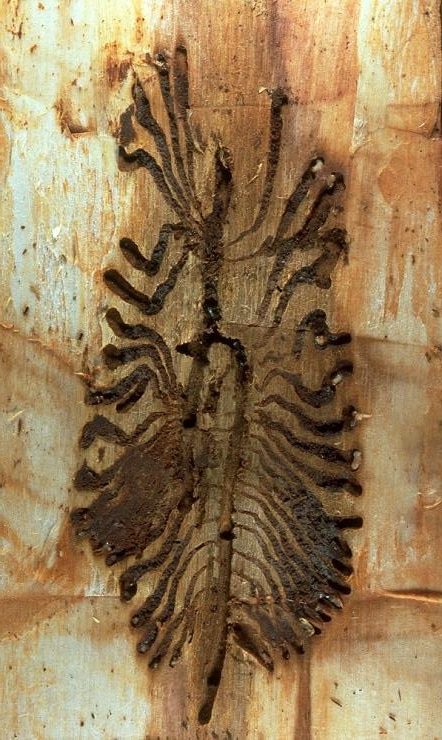
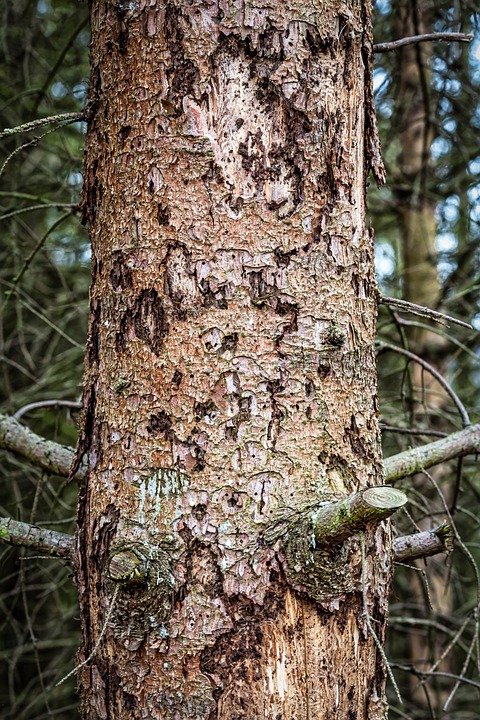
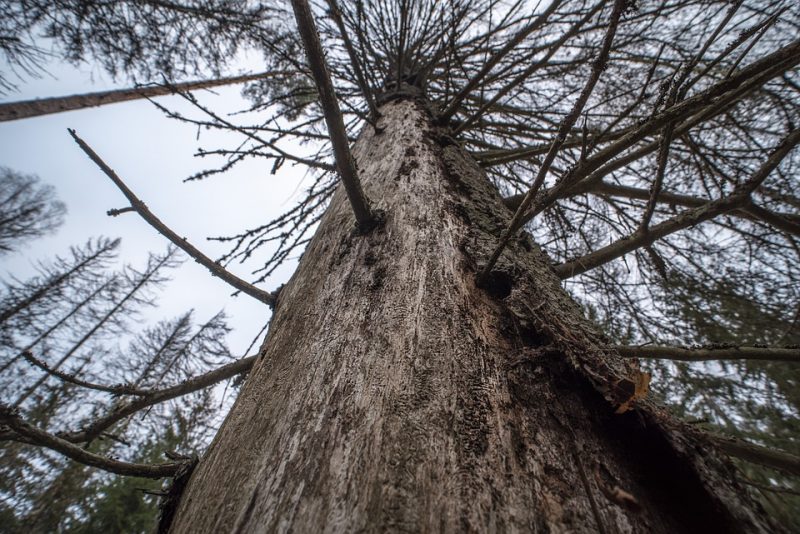
Pheromone-baited and chemically treated trap logs can also be used for monitoring and control. These are destroyed when the insects are in the larval or pupa stage, under the bark. If the traps are not destroyed in time, it is recommended to treat them with specific insecticides. Before, respectively after the flight, contact insecticides with the capacity to penetrate through the bark can be used. Systemic insecticides are recommended to be used, especially in the larval stage.
Recommended products
-
You can find products on a different store
Change Store -
You can find products on a different store
Change Store -
You can find products on a different store
Change Store -
You can find products on a different store
Change Store -
You can find products on a different store
Change Store -
You can find products on a different store
Change Store -
You can find products on a different store
Change Store -
You can find products on a different store
Change Store -
You can find products on a different store
Change Store -
You can find products on a different store
Change Store -
You can find products on a different store
Change Store -
You can find products on a different store
Change Store -
You can find products on a different store
Change Store -
You can find products on a different store
Change Store -
You can find products on a different store
Change Store -
You can find products on a different store
Change Store -
You can find products on a different store
Change Store -
You can find products on a different store
Change Store -
You can find products on a different store
Change Store -
You can find products on a different store
Change Store -
You can find products on a different store
Change Store -
You can find products on a different store
Change Store -
You can find products on a different store
Change Store -
You can find products on a different store
Change Store
Ips amitinus – small spruce bark beetle
These spruce pests have been reported together with other bark beetles, very frequently with Ips typographus. It attacks spruce, rarely fir and larch, preferring thick branches with smooth bark, located in the topside of the stem. It usually develops two generations a year, flying in April-May and in June-July. Frequently, it overwinters in the adult stage, less often in the egg, larval or pupa stages. The damage is caused by larvae and beetles, by chewing nuptial chambers and galleries under the bark of trees. 3-7 mother galleries start from the nuptial chambers, imprinted on the wood.
Control methods. First of all, it is recommended to monitor the population and detect the outbreaks in time, by observing the beetles during the flight and by identifying the entrance holes on the bark. Because it can become a primary pest (attacking healthy trees), a tree is considered infested when even a single gallery system is found on its trunk. Both for detection and for control, pheromone-baited and chemically treated trap logs and trap trees are used. Systemic or contact insecticides (with the ability to penetrate under the bark) are recommended to be used primarily in the larval stage.
Recommended products
-
You can find products on a different store
Change Store -
You can find products on a different store
Change Store -
You can find products on a different store
Change Store -
You can find products on a different store
Change Store -
You can find products on a different store
Change Store -
You can find products on a different store
Change Store -
You can find products on a different store
Change Store -
You can find products on a different store
Change Store -
You can find products on a different store
Change Store -
You can find products on a different store
Change Store -
You can find products on a different store
Change Store -
You can find products on a different store
Change Store -
You can find products on a different store
Change Store -
You can find products on a different store
Change Store -
You can find products on a different store
Change Store -
You can find products on a different store
Change Store -
You can find products on a different store
Change Store -
You can find products on a different store
Change Store -
You can find products on a different store
Change Store -
You can find products on a different store
Change Store -
You can find products on a different store
Change Store -
You can find products on a different store
Change Store -
You can find products on a different store
Change Store -
You can find products on a different store
Change Store
Pityogenes chalcographus – six-dentate spruce bark beetle
It is also known as the ‘small European spruce bark beetle’. It usually attacks spruce, rarely it was reported on fir, pine and larch. Young trees, aged 8-12, and the tops and branches of old trees are often damaged. Prefers thin bark and attacks in association with Ips typographus and Ips amitinus. It has 1-2 generations per year and it overwinters in the larval, pupa, or adult stage. Damages are caused by gnawing galleries under the bark and in the thickness of the bark, made by beetles (3-6 mother-galleries of 3-8 cm length each) and larvae (larval galleries of maximum 3 cm length). The gnawing is imprinted on the bark, the mother galleries form a star-like shape.
Control methods. It is a secondary pest that rarely attacks healthy trees. It is recommended to use trap logs: thin trunks and thicker branches with pheromone baits. These traps are destroyed after being colonized by insects. Contact or systemic insecticides can also be used.
Recommended products
-
You can find products on a different store
Change Store -
You can find products on a different store
Change Store -
You can find products on a different store
Change Store -
You can find products on a different store
Change Store -
You can find products on a different store
Change Store -
You can find products on a different store
Change Store -
You can find products on a different store
Change Store -
You can find products on a different store
Change Store -
You can find products on a different store
Change Store -
You can find products on a different store
Change Store -
You can find products on a different store
Change Store -
You can find products on a different store
Change Store -
You can find products on a different store
Change Store -
You can find products on a different store
Change Store -
You can find products on a different store
Change Store -
You can find products on a different store
Change Store -
You can find products on a different store
Change Store -
You can find products on a different store
Change Store -
You can find products on a different store
Change Store -
You can find products on a different store
Change Store -
You can find products on a different store
Change Store -
You can find products on a different store
Change Store -
You can find products on a different store
Change Store -
You can find products on a different store
Change Store
Pityophthorus micrographus – bark beetle
The attack of these spruce pests occurs especially on thin trees. It has two generations a year and overwinters as an adult. Damages are caused by gnawing between bark and wood. The females gnaw mother galleries: 4-7 females from a single nuptial chamber. The pupation takes place at the end of each larval gallery and is imprinted in bark (unlike the rest of the galleries, which are imprinted in wood).
Control methods. As in the case of other bark beetles, population monitoring and early detection of outbreaks are recommended. For both detection and control, trap trees and trap logs are used. In case of outbreaks, the use of contact or systemic insecticides may be taken into consideration.
Recommended products
-
You can find products on a different store
Change Store -
You can find products on a different store
Change Store -
You can find products on a different store
Change Store -
You can find products on a different store
Change Store -
You can find products on a different store
Change Store -
You can find products on a different store
Change Store -
You can find products on a different store
Change Store -
You can find products on a different store
Change Store -
You can find products on a different store
Change Store -
You can find products on a different store
Change Store -
You can find products on a different store
Change Store -
You can find products on a different store
Change Store -
You can find products on a different store
Change Store -
You can find products on a different store
Change Store -
You can find products on a different store
Change Store -
You can find products on a different store
Change Store -
You can find products on a different store
Change Store -
You can find products on a different store
Change Store -
You can find products on a different store
Change Store -
You can find products on a different store
Change Store -
You can find products on a different store
Change Store -
You can find products on a different store
Change Store -
You can find products on a different store
Change Store -
You can find products on a different store
Change Store
Polygraphus poligraphus
It is often reported on spruce, especially on young trees (20-40 years old). Damages are produced on the trunk and branches. These spruce pests usually have one generation a year, with the flight in April-May. It usually overwinters in the adult stage. Damages are caused by beetles and larvae, which gnaw between bark and wood. Both the mother and the larval galleries are irregular, printed on the inside part of the bark. Usually, 3-8 mother galleries start from a nuptial chamber. Mostly horizontal, very short galleries can be observed on the wood.
Control methods. Early detection of outbreaks is recommended. Pheromone-baited trap trees and logs can be used both for population monitoring and for control purposes. In case of outbreaks, the use of insecticides can be taken into consideration.
Recommended products
-
You can find products on a different store
Change Store -
You can find products on a different store
Change Store -
You can find products on a different store
Change Store -
You can find products on a different store
Change Store -
You can find products on a different store
Change Store -
You can find products on a different store
Change Store -
You can find products on a different store
Change Store -
You can find products on a different store
Change Store -
You can find products on a different store
Change Store -
You can find products on a different store
Change Store -
You can find products on a different store
Change Store -
You can find products on a different store
Change Store -
You can find products on a different store
Change Store -
You can find products on a different store
Change Store -
You can find products on a different store
Change Store -
You can find products on a different store
Change Store -
You can find products on a different store
Change Store -
You can find products on a different store
Change Store -
You can find products on a different store
Change Store -
You can find products on a different store
Change Store -
You can find products on a different store
Change Store -
You can find products on a different store
Change Store -
You can find products on a different store
Change Store -
You can find products on a different store
Change Store
Dendroctonus micans – great spruce bark beetle
It is a primary pest of spruce in case of outbreaks. It prefers the lower part of the trunk, as well as the thick roots of the old trees. Usually, it has a generation in 2 years, rarely one generation per year. The flight is in July and the species overwinters as a larva in the first year and as an adult in the second year. These spruce pests attack both healthy and weakened trees. The mother gallery is irregular and has a length of 6-15 cm. The larvae gnaw together, widening the mother gallery. Leaks of resin and sawdust can be observed at the base of the galleries. The bark of the attacked trees exfoliates and detaches, starting from the affected area (at the base of the trunk).
Control methods. Being considered a primary pest, it is recommended to monitor these spruce pests and detect outbreaks in time. Beetles can be observed during the flight, and the entrance and vent holes of the galleries can be detected at any time of the year. It is recommended to cut, pee,l and destroy/process the affected trees as soon as possible. Pheromone-baited trap trees and trap logs, as well as insecticides of various types, can also be considered.
Recommended products
-
You can find products on a different store
Change Store -
You can find products on a different store
Change Store -
You can find products on a different store
Change Store -
You can find products on a different store
Change Store -
You can find products on a different store
Change Store -
You can find products on a different store
Change Store -
You can find products on a different store
Change Store -
You can find products on a different store
Change Store -
You can find products on a different store
Change Store -
You can find products on a different store
Change Store -
You can find products on a different store
Change Store -
You can find products on a different store
Change Store -
You can find products on a different store
Change Store -
You can find products on a different store
Change Store -
You can find products on a different store
Change Store -
You can find products on a different store
Change Store -
You can find products on a different store
Change Store -
You can find products on a different store
Change Store -
You can find products on a different store
Change Store -
You can find products on a different store
Change Store -
You can find products on a different store
Change Store -
You can find products on a different store
Change Store -
You can find products on a different store
Change Store -
You can find products on a different store
Change Store
Cryphalus abietis
This pest frequently attacks spruce, more rarely it can be found on other conifers. Prefers the top area of the 20-40 years old trees. It has 2 generations per year, with the flight in March-April and in July-August. It usually overwinters in the adult stage. The female gnaws in the bark or between the bark and the wood an irregular mother gallery, in which she lays eggs. After their hatch, the larvae gnaw sinuous galleries, oriented in all directions (with a tendency to verticality). Thus, the attack has a starry appearance. The pupation takes place deep either in the bark or in wood.
Control methods. It is recommended to monitor insect populations and control them in case of mass multiplication. The use of pheromone traps and contact or systemic insecticides is recommended in case of these spruce pests.
Recommended products
-
You can find products on a different store
Change Store -
You can find products on a different store
Change Store -
You can find products on a different store
Change Store -
You can find products on a different store
Change Store -
You can find products on a different store
Change Store -
You can find products on a different store
Change Store -
You can find products on a different store
Change Store -
You can find products on a different store
Change Store -
You can find products on a different store
Change Store -
You can find products on a different store
Change Store -
You can find products on a different store
Change Store -
You can find products on a different store
Change Store -
You can find products on a different store
Change Store -
You can find products on a different store
Change Store -
You can find products on a different store
Change Store -
You can find products on a different store
Change Store -
You can find products on a different store
Change Store -
You can find products on a different store
Change Store -
You can find products on a different store
Change Store -
You can find products on a different store
Change Store -
You can find products on a different store
Change Store -
You can find products on a different store
Change Store -
You can find products on a different store
Change Store -
You can find products on a different store
Change Store
Cydia strobilella – spruce seed moth
They are widespread spruce pests that attack spruce cones and which can destroy up to 60% of the annual cone production. It develops one generation per year and overwinters in the larval stage, in the axis of the cone, or at the base of the scales. The larva gnaws at the base of a cone’s scales and penetrates its axis, after which it gnaws the seeds and the base of the scales. The attacked cones dehydrate, bend, the scales do not open up, resin drops appear on their surface, and finally, they fall to the ground. After the flight of the adults (moths), the pupal exudations can be observed between the scales of the attacked cones.
Control methods. Monitoring can be done with pheromone traps. It is recommended to gather and destroy the attacked cones (by burning). Chemical control with systemic or contact insecticides can be carried out at any stage of development. In the egg or larval stage, insect growth regulators can be applied.
Recommended products
-
You can find products on a different store
Change Store -
You can find products on a different store
Change Store -
You can find products on a different store
Change Store -
You can find products on a different store
Change Store -
You can find products on a different store
Change Store -
You can find products on a different store
Change Store -
You can find products on a different store
Change Store -
You can find products on a different store
Change Store -
You can find products on a different store
Change Store -
You can find products on a different store
Change Store -
You can find products on a different store
Change Store -
You can find products on a different store
Change Store -
You can find products on a different store
Change Store -
You can find products on a different store
Change Store -
You can find products on a different store
Change Store -
You can find products on a different store
Change Store -
You can find products on a different store
Change Store -
You can find products on a different store
Change Store -
You can find products on a different store
Change Store -
You can find products on a different store
Change Store -
You can find products on a different store
Change Store -
You can find products on a different store
Change Store -
You can find products on a different store
Change Store -
You can find products on a different store
Change Store
Lymantria monacha – black-arched tussock moth
It is also known as ‘nun moth’ or ‘black arches moth’. It is a polyphagous species that attacks especially conifers but is also found on deciduous trees. Most of the damages are on spruce, but the pest is found on pines, firs, larches, and douglas fir. It produces strong attacks in pure spruce forests. It has one generation per year, flying in the evening and at night, in July-August (rarely until September). The nun moth overwinters in the egg stage. The attack begins in early spring when the young buds are red, barely open. Until the conifer buds open, the larvae feed on the leaves of deciduous trees. The attack starts from the base of the crown and advances to the top, and from the inside part of the crown to the outside. In case of a strong attack, with a defoliation rate of over 60%, the tree dries out.
Control methods. Pheromone traps are used to monitor and control this pest. Sticky panel pheromone traps should be installed before the flight of the adults start. In addition, mechanical control can be performed by gathering and destroying the egg bunches. These can be seen both in autumn and spring: on the trunk, in the cracks or under the scales of the bark, in the moss or lichens. In case of outbreaks, contact, systemic or ingestion insecticides can be used. Insect growth regulators can be applied in the egg or larval stage.
Recommended products
-
You can find products on a different store
Change Store -
You can find products on a different store
Change Store -
You can find products on a different store
Change Store -
You can find products on a different store
Change Store -
You can find products on a different store
Change Store -
You can find products on a different store
Change Store -
You can find products on a different store
Change Store -
You can find products on a different store
Change Store -
You can find products on a different store
Change Store -
You can find products on a different store
Change Store -
You can find products on a different store
Change Store -
You can find products on a different store
Change Store -
You can find products on a different store
Change Store -
You can find products on a different store
Change Store -
You can find products on a different store
Change Store -
You can find products on a different store
Change Store -
You can find products on a different store
Change Store -
You can find products on a different store
Change Store -
You can find products on a different store
Change Store -
You can find products on a different store
Change Store -
You can find products on a different store
Change Store -
You can find products on a different store
Change Store -
You can find products on a different store
Change Store -
You can find products on a different store
Change Store
Pristiphora abietina – gregarious spruce sawfly
It is also known as the ‘lesser spruce sawfly’ and it causes damage to spruce trees located on sunny slopes or in places without powerful air currents. 10-30 years old plantations are especially attacked. It has one generation per year and overwinters in the soil, in the larval stage. The females lay eggs at the top of the crown, between the young needle bunches. These needles fade, dry, and remain on the shoots. The larvae gnaw healthy and young needles, causing defoliation. Numerous buds develop on the attacked shoots. Repeated attacks lead to “witch broom” type tight growths, and then to the drying of the shoots. The attack is often noticed too late, during the winter.
Control methods. The natural predators (eg. insectivorous birds or ants) of this pest should be protected. Pure spruce plantations outside their natural range should be avoided, and mixed stands with a high percentage of deciduous trees should be promoted. It is also recommended to administer calcium-based fertilizers. Pest control with chemical insecticides is done in the larval stage and is repeated periodically. Also, specific treatments can be applied in order to inhibit the synthesis of chitin.
Recommended products
-
You can find products on a different store
Change Store -
You can find products on a different store
Change Store -
You can find products on a different store
Change Store -
You can find products on a different store
Change Store -
You can find products on a different store
Change Store -
You can find products on a different store
Change Store -
You can find products on a different store
Change Store -
You can find products on a different store
Change Store -
You can find products on a different store
Change Store -
You can find products on a different store
Change Store -
You can find products on a different store
Change Store -
You can find products on a different store
Change Store -
You can find products on a different store
Change Store -
You can find products on a different store
Change Store -
You can find products on a different store
Change Store -
You can find products on a different store
Change Store -
You can find products on a different store
Change Store -
You can find products on a different store
Change Store -
You can find products on a different store
Change Store -
You can find products on a different store
Change Store -
You can find products on a different store
Change Store -
You can find products on a different store
Change Store -
You can find products on a different store
Change Store -
You can find products on a different store
Change Store
Megastigmus strobilobius – spruce seed chalcid
It is found in many areas with spruce stands, causing losses of about 5% of seeds. The cones of different conifers are attacked, especially spruce cones. It has one generation a year and overwinters as a larva in the infested seeds. The larvae consume the content of the seeds. Round holes through which the insects came out in the adult stage can be observed on the infested seeds.
Control methods. Chemical treatments are recommended during the flight of the insects. Also, heat treatments of the seeds can be carried out, at temperatures of 50-55 ℃, without diminishing the germination capacity.
Recommended products
-
You can find products on a different store
Change Store -
You can find products on a different store
Change Store -
You can find products on a different store
Change Store -
You can find products on a different store
Change Store -
You can find products on a different store
Change Store -
You can find products on a different store
Change Store -
You can find products on a different store
Change Store -
You can find products on a different store
Change Store -
You can find products on a different store
Change Store -
You can find products on a different store
Change Store -
You can find products on a different store
Change Store -
You can find products on a different store
Change Store -
You can find products on a different store
Change Store -
You can find products on a different store
Change Store -
You can find products on a different store
Change Store -
You can find products on a different store
Change Store -
You can find products on a different store
Change Store -
You can find products on a different store
Change Store -
You can find products on a different store
Change Store -
You can find products on a different store
Change Store -
You can find products on a different store
Change Store -
You can find products on a different store
Change Store -
You can find products on a different store
Change Store -
You can find products on a different store
Change Store
Epiblema tedella – spruce needle miner
It causes damage, especially in young spruce stands (10-30 years old) and well-lit, rare ones. Pine and fir trees are rarely affected. It has one generation a year, with the flight in May-June. It overwinters in the larval stage, in the litter. The damages are caused by the larvae, which first mine the needles, after which they gnaw them completely. Nests of 10-15 needles caught with silk threads are formed. The attacked trees can dry out completely after several repeated attacks.
Control methods. Mechanical control consists of gathering and burning larvae nests, and chemical control is done with insecticides. The latter is recommended for use in the evening or at night when larvae leave their nests. Also, insect growth regulator treatments can be applied to block the formation of chitin of these spruce pests.
Recommended products
-
You can find products on a different store
Change Store -
You can find products on a different store
Change Store -
You can find products on a different store
Change Store -
You can find products on a different store
Change Store -
You can find products on a different store
Change Store -
You can find products on a different store
Change Store -
You can find products on a different store
Change Store -
You can find products on a different store
Change Store -
You can find products on a different store
Change Store -
You can find products on a different store
Change Store -
You can find products on a different store
Change Store -
You can find products on a different store
Change Store -
You can find products on a different store
Change Store -
You can find products on a different store
Change Store -
You can find products on a different store
Change Store -
You can find products on a different store
Change Store -
You can find products on a different store
Change Store -
You can find products on a different store
Change Store -
You can find products on a different store
Change Store -
You can find products on a different store
Change Store -
You can find products on a different store
Change Store -
You can find products on a different store
Change Store -
You can find products on a different store
Change Store -
You can find products on a different store
Change Store
Physokermes piceae – spruce bud scale
They are common spruce pests (less often found on fir), both in forests and in horticultural arrangements or gardens. It has one generation per year and overwinters in the larval stage, especially on needles or at the base of buds. Damages are caused by sucking sap from the shoots. These insects prefer the shoots located at the lower part of the crown. In case of severe attacks, the lower branches vegetate poorly, sometimes dry out. The attacked trees are weakened and prone to other pest attacks.
Control methods. In the case of isolated trees, of small dimensions, mechanical control can be performed by breaking and destroying the attacked and dried branches. In case of outbreaks, chemical treatments with specific insecticides can be applied.
Recommended products
-
You can find products on a different store
Change Store -
You can find products on a different store
Change Store -
You can find products on a different store
Change Store -
You can find products on a different store
Change Store -
You can find products on a different store
Change Store -
You can find products on a different store
Change Store -
You can find products on a different store
Change Store -
You can find products on a different store
Change Store -
You can find products on a different store
Change Store -
You can find products on a different store
Change Store -
You can find products on a different store
Change Store -
You can find products on a different store
Change Store -
You can find products on a different store
Change Store -
You can find products on a different store
Change Store -
You can find products on a different store
Change Store -
You can find products on a different store
Change Store -
You can find products on a different store
Change Store -
You can find products on a different store
Change Store -
You can find products on a different store
Change Store -
You can find products on a different store
Change Store -
You can find products on a different store
Change Store -
You can find products on a different store
Change Store -
You can find products on a different store
Change Store -
You can find products on a different store
Change Store














































































































































































































































































































































































































































